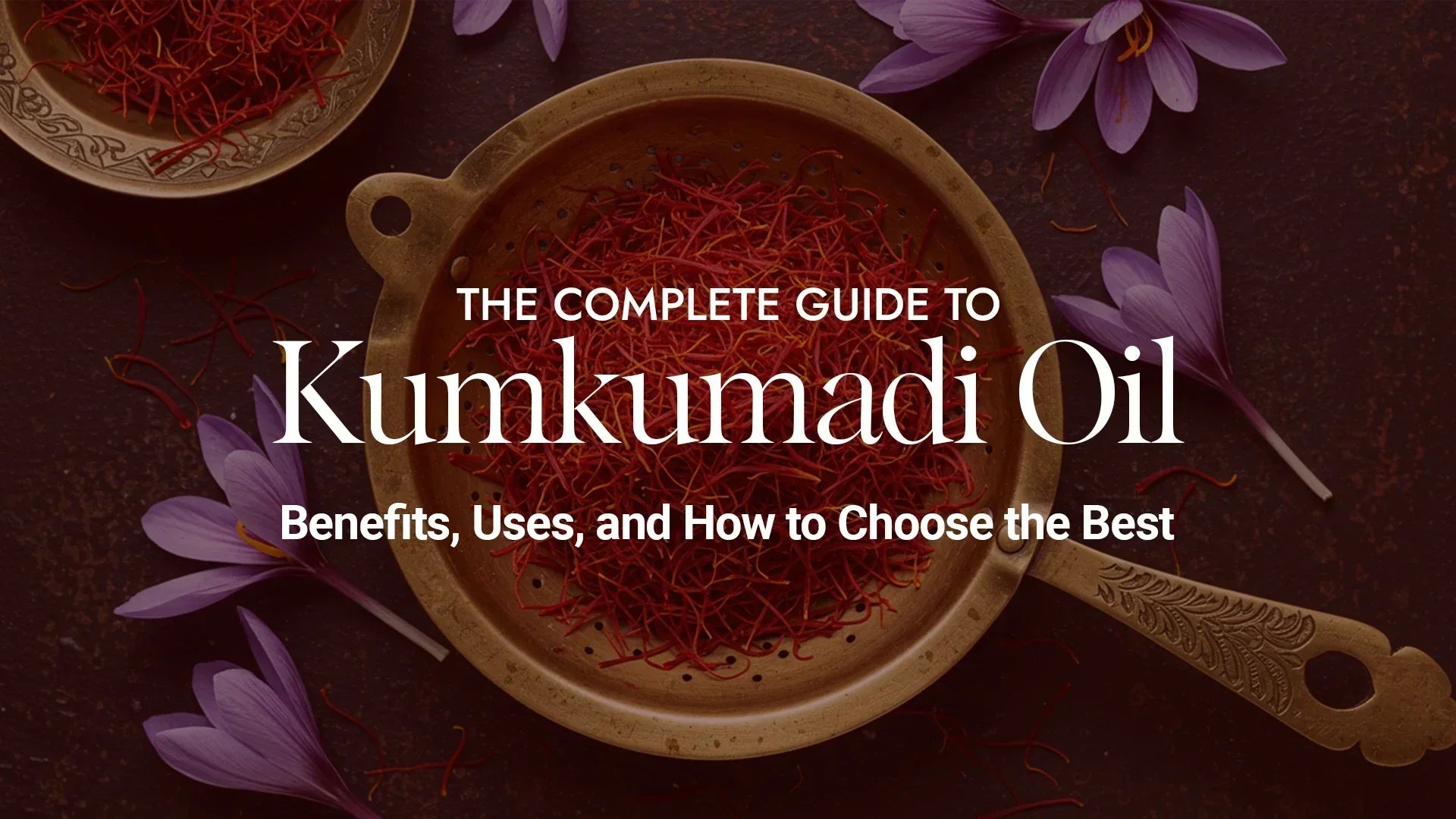Kumkumadi Oil for Sensitive & Acne-Prone Skin: Is It Safe?

If you have sensitive or acne-prone skin, you probably approach new skincare products with hesitation. One wrong oil or cream, and you're left managing breakouts, redness, or stinging that takes days to calm down.
Kumkumadi oil is widely celebrated for its glow-boosting and pigmentation-fading properties. But when your skin reacts to almost everything, the real question is; can it actually work for you? Let’s explore that. But not just with a yes or no, we’ll walk through how it works, what Ayurveda says, and what modern science supports before we get to the answer.
Understanding Your Skin First
Before anything else, it's essential to understand why sensitive and acne-prone skin react the way they do.
- Sensitive skin tends to overreact to fragrances, preservatives, and certain essential oils. It may burn, sting, or flare up even from “natural” ingredients.
- Clogged pores, excess sebum, or inflammation trigger acne-prone skin. Some oils can worsen the situation if they're too thick or comedogenic (pore-clogging).
That means not every "natural" oil is automatically good for these skin types. But not all oils are bad either, especially when they’re formulated carefully and used correctly.
Does Kumkumadi Oil Work for Acne-Prone Skin
Despite being an oil, Kumkumadi Tailam includes a selection of Ayurvedic herbs specifically chosen for their purifying, calming, and regenerating properties.
Let’s look at some of them:
- Manjistha (Indian madder) is well-known in Ayurveda for cleansing the blood and detoxifying skin. It helps reduce inflammation and fade acne marks over time.
- Licorice (Mulethi) gently inhibits melanin production, lightens scars and pigmentation, and soothes post-acne redness.
- Turmeric (Haldi) has scientifically proven anti-inflammatory and antimicrobial benefits. It supports wound healing and helps prevent clogged pores.
- Neem is a powerful antibacterial herb used for centuries in Ayurvedic acne treatments. It targets bacteria and supports clearer, calmer skin.
- Saffron, the hero ingredient, is loaded with antioxidants and has been shown in studies to reduce pigmentation and promote a healthy glow.
This combination makes Kumkumadi oil more than just a moisturising oil; it becomes a targeted treatment for skin that's been through breakouts and is trying to recover.
But What About Sensitive Skin?
This is where it gets interesting. Many ingredients in Kumkumadi oil are not just tolerated by sensitive skin, they’re actually prescribed in Ayurveda to treat it.
- Sandalwood cools and calms redness.
- Licorice reduces inflammation and protects against UV damage.
- Almond oil is rich in vitamin E and essential fatty acids that nourish without overwhelming the skin.
Modern dermatological research also supports these claims. Turmeric and licorice have both been studied for their anti-inflammatory and anti-irritant effects. Combined with a non-comedogenic base like sesame oil, the formulation becomes suitable for skin that reacts to nearly everything else.
Of course, patch testing is still essential. Apply a small drop on the jawline or inner elbow and wait 24 hours. If there’s no reaction, you’re good to go.
How to Safely Use It If You’re Acne-Prone or Sensitive
If you're curious to try Kumkumadi oil, here's how to do it right:
- Start slow: Use it 2–3 nights a week and watch how your skin responds. Increase frequency only if your skin tolerates it well.
- Use less than you think: 1–2 drops are enough for the entire face. More product won’t mean faster results; it just risks congestion.
- Apply to clean, dry skin: Avoid layering it on top of actives like AHA/BHA or prescription
It’s recommended to follow this routine daily before going to sleep at night.
What to Expect (and What Not To)
To better set your expectations for Kumkumadi oil, here’s a list of the things you can expect after accurately applying this oil:
- Calming inflammation
- Soothing irritation
- Evening out the patchy tone
- Fading acne marks
- Fading dark spots and pigmentation marks
- Supporting natural glow
Here’s what the Kumkumadi oil doesn’t do:
- Treat active cystic acne
- Replace prescription meds
- Show instant results (it’s a 4–8 week journey)
Give it time. And if breakouts persist or worsen, discontinue use and revisit your core routine.
Final Thoughts
Kumkumadi oil can be both safe and beneficial for acne-prone and sensitive skin. However, it depends entirely on the quality of the formulation and how it is used.
Choose a clean, well-crafted oil with transparent ingredients. Start small, go slow, and pay attention to how your skin reacts.
And remember, no one product is a miracle fix, but when you treat your skin gently and consistently, progress becomes inevitable.




